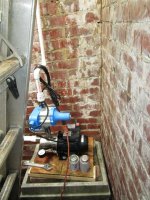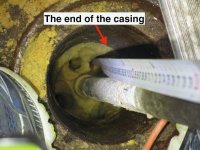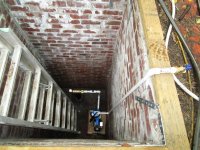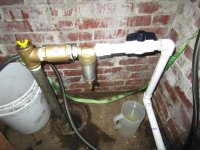John Livingston
New Member
This well, in Newport News, VA, was likely put in when the house was built 80+ years ago. I want to reactivate it, but the foot valve, not surprisingly, is not keeping water in the 1.25” pipe. I’m looking on suggestions for getting the pipe out so I can replace it.
I’ve lived here 26 years and the well has not been operated in that time. The original pump was completely rusted out and tossed. I’ve bought a Burcam 506532SS ¾ HP pump, which is what Burcam recommended for my application, which is to just use the water to irrigate the lawn. I also installed a check valve and a sand filter.
The brick shaft is 8 feet deep, with a concrete floor. The well casing goes down another two feet, then there’s lots of fairly clean sand, so it may just be the regular subsoil at that point. I’ve dropped lines down the pipe and see water at 20 feet from the top of the pipe (which is a couple of feet off the floor of the shaft). I can’t get anything to go farther down the pipe than 24 feet, so that’s either the end of the pipe, or it’s obstructed. I’ve been using a small shop vac with lots of extensions to pull up the sand between the pipe and the casing. I seem to hit a firm surface a little more than five feet down from the top of the casing.
I thought I’d continue to vacuum up the sand around the well pipe down to that firm surface. That should leave about 7 feet of pipe exposed, with at least another 17 feet buried. Would you use car jacks (fun getting those down the ladder!) to break it loose? I’ve got an engine hoist I could probably move over the shaft. I’ve also got a Nifty Lift that I could use. It’s rated at 440 pounds, I think, so, again, it’d be best to have broken the pipe loose with something else first. Come to think of it, I’ve got a fairly heavy duty, 12V winch I could easily mount to a 4x4 over the shaft. That’s probably the best route.
I know next to nothing about how these things are constructed, over what a brief survey of the interwebs has turned up, so if I’m overlooking something, or doing anything foolish, please let me know.
I’ll attach a few pictures, but it’s very hard to get a clear shot down to where the sand is. One shot, I think, shows the pump below the well head, which Burwell quickly told me was wrong. Its input is now a bit above the well head.
John
I’ve lived here 26 years and the well has not been operated in that time. The original pump was completely rusted out and tossed. I’ve bought a Burcam 506532SS ¾ HP pump, which is what Burcam recommended for my application, which is to just use the water to irrigate the lawn. I also installed a check valve and a sand filter.
The brick shaft is 8 feet deep, with a concrete floor. The well casing goes down another two feet, then there’s lots of fairly clean sand, so it may just be the regular subsoil at that point. I’ve dropped lines down the pipe and see water at 20 feet from the top of the pipe (which is a couple of feet off the floor of the shaft). I can’t get anything to go farther down the pipe than 24 feet, so that’s either the end of the pipe, or it’s obstructed. I’ve been using a small shop vac with lots of extensions to pull up the sand between the pipe and the casing. I seem to hit a firm surface a little more than five feet down from the top of the casing.
I thought I’d continue to vacuum up the sand around the well pipe down to that firm surface. That should leave about 7 feet of pipe exposed, with at least another 17 feet buried. Would you use car jacks (fun getting those down the ladder!) to break it loose? I’ve got an engine hoist I could probably move over the shaft. I’ve also got a Nifty Lift that I could use. It’s rated at 440 pounds, I think, so, again, it’d be best to have broken the pipe loose with something else first. Come to think of it, I’ve got a fairly heavy duty, 12V winch I could easily mount to a 4x4 over the shaft. That’s probably the best route.
I know next to nothing about how these things are constructed, over what a brief survey of the interwebs has turned up, so if I’m overlooking something, or doing anything foolish, please let me know.
I’ll attach a few pictures, but it’s very hard to get a clear shot down to where the sand is. One shot, I think, shows the pump below the well head, which Burwell quickly told me was wrong. Its input is now a bit above the well head.
John




